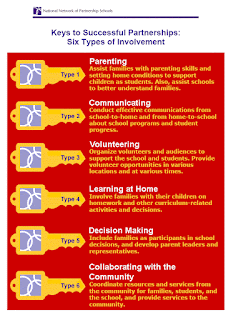Epstein's Framework of Six Types of Involvement lists the most effective means for teachers and families to build a long standing and strong connection to best benefit the respective student and child. The establishment of a sound relationship that encourages interaction from both the teacher and the parents is critical in a student's ability to reach their full potential. Learning is a constant process that must take place not only at school, but at home as well. Teachers and parents working in tandem to develop continuous learning demonstrates to students the importance of life long education. It also presents to students the value that both their teachers and parents place in their success. The two types I want to focus on as an educator are communicating and learning at home.
Communicating means establishing an effective process to relay information from school to home and back about the student's progress and school activities. This results in parents being more aware of their child's sustains and improvements, helps teachers understand family views and diversity better, and creates better awareness for students of school programs. This can be practiced by weekly progress reports sent by students to families or emails directly to parents. Face to face conferences or Skype meetings can also be an effective way to convey information and concerns to and from parents and teachers. Challenges can be if the parents do not speak English or if the parents do not respond timely to the teacher's information.
Learning from home works in connection with communicating and provides information and ideas to families to help students at home with homework or activities. This can result in better homework completion, increased test scores, better understanding by parents of their student's work and learning, and in teachers have better input in the design of their assignments. Learning from home can be practiced by having teachers establishing assignment calenders for students and parents, having family activities at school, and disseminating information to parents on homework requirements and policies. The challenge can be in coordinating interactive activities that can be completed at home with families.
When I become an educator, I believe that open communication with parents is the most important commodity I can obtain. The challenge is to show parents that I value their input, but that I must also be aware of how to best develop their student's education. I am sure that this can be a fine line to institute, but communication will hopefully establish trust in what we want the student to accomplish.

No comments:
Post a Comment